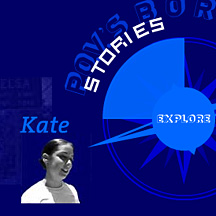|
Webumentary tryout Originally published in Current,
Oct. 21, 2002 An experiment in "webumentary" production is running live at www.pbs.org/pov/borders through mid-December. Borders, a web-only strand created by P.O.V., debuted Oct. 8 as an interactive, real-life drama exploring the topic of migration through video diaries, dialogue and other creative expressions.
The 10-week production cycle operates almost like a TV magazine, sitcom or soap opera, said Bernardo Ruiz, producer. "Only we have very little control over what's coming in." Each of the students had some media training before selection for the series. Their coming-of-age stories bring out "issues of class and identity and where they are in their lives," said Ruiz. Visitors to the site can post comments or questions and "potentially affect the outcome of the activity." "Border Journeys," another feature of the site, presents original material by filmmaker Hannah Weyer, whose documentaries on migrant life aired on P.O.V. Scenes are adapted from her recent film, "Escuela," and follow a family's year-long migration. In other sections, featured guests join electronic conversations with visitors, and work by digital media artist Alex Rivera opens a gallery where visitors can contribute their own art, verse or video. Executive Producer Cara Mertes began developing plans for web-only production when she joined P.O.V. more than two years ago. Borders relates to films in the series but also stands alone, she said, and positions itself for "three to five years down the road when people are looking for directly streamed material." P.O.V. Interactive plans another Borders "episode" on the environment to launch in April. Mertes proposed Borders to test how to harness interactive elements for compelling storytelling, how to showcase a web-only series, and "how to make it educationally vital, knowing that teachers are using it more and more in the classroom," she said. Ten weeks of live production and an afterlife that adds visitors' postings cost about $100,000, Mertes said. "It's a really economical way to draw an entirely new audience and use social issue material in very new ways." That's still a lot for a website, she acknowledged, but the original video content, rights expenses, and weekly cycle of editing new footage make Borders "more like a television series that happens to be conceived for the Web." PBS invests very selectively in web-only content, but it backed this pilot, said Cindy Johanson, senior v.p., interactive learning. Mertes's plan for Borders as a laboratory for web storytelling was especially appealing, she said. The series also has a shot at attracting a dedicated community of new users who don't watch PBS. |
These days, transmitters have little or nothing to do with some things put out by public broadcasters. Current cites some sites: New doors to old content: WNET's African American World and WGBH's Global Connections Niche streamer: WAMU's BluegrassCountry.org Campaigns a la carte: NewsHour Online's Vote 2002 Webumentary tryout: P.O.V.'s Borders Toolmaker for station sites: Public Interactive. Follow the reporters: Frontline's pre-broadcast diary. |
 |
To Current's home page |
 |
Outside link: Borders. |
Web page posted Nov. 5,
2002
Current
The newspaper about public television and radio
in the United States
A service of Current Publishing Committee, Takoma Park, Md.
E-mail: web![]() current.org
current.org
301-270-7240
Copyright 2002

 Its
main feature is the webumentary Leaving Elsa, in which three young adults
from the border town of Elsa, Texas, record their daily lives on digital
video. Producers at P.O.V. in New York edit new diary installments each
week, compress them digitally and upload them to the website on Tuesdays.
Its
main feature is the webumentary Leaving Elsa, in which three young adults
from the border town of Elsa, Texas, record their daily lives on digital
video. Producers at P.O.V. in New York edit new diary installments each
week, compress them digitally and upload them to the website on Tuesdays.